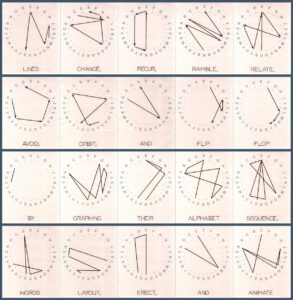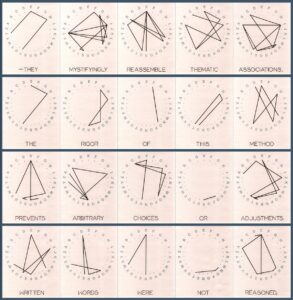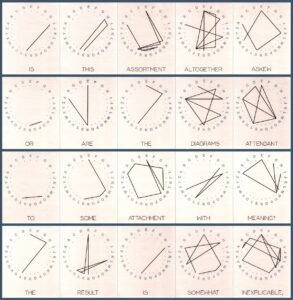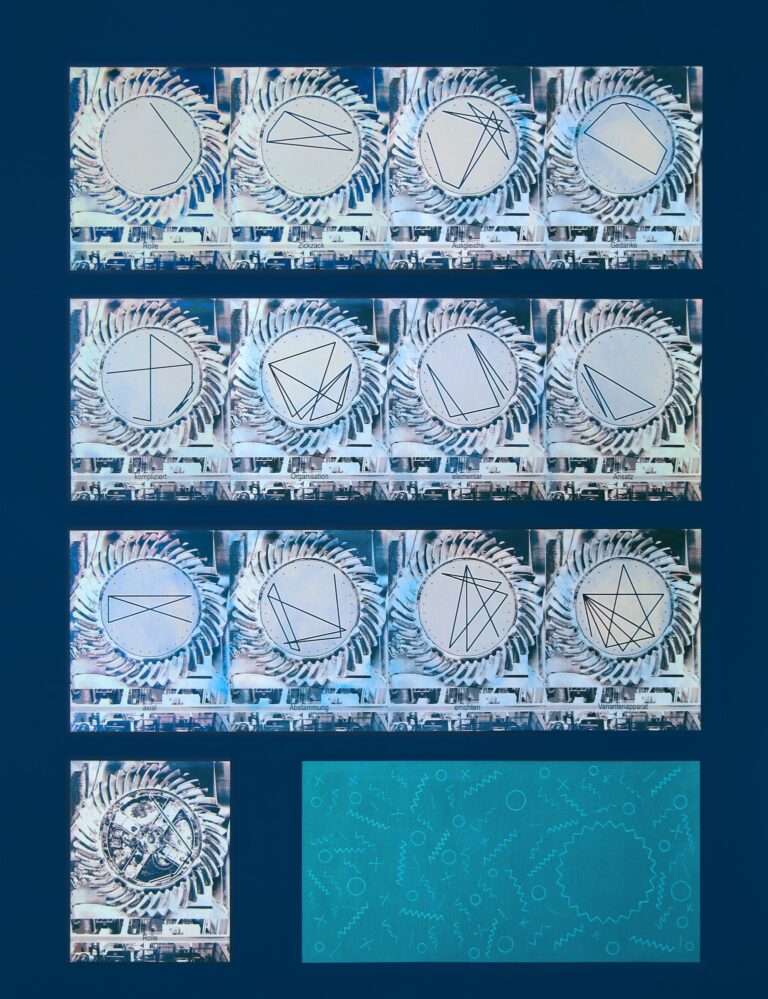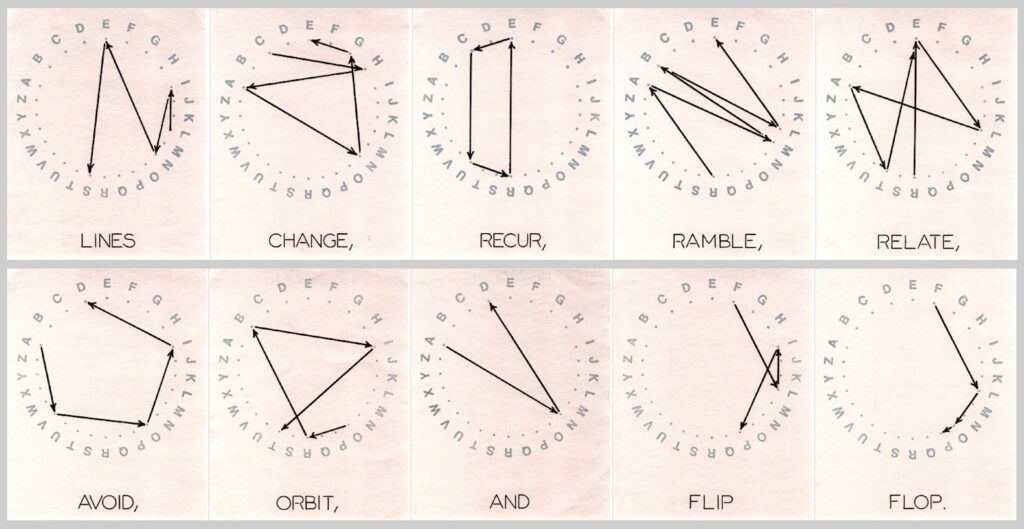
All of Michael Winkler’s individual works explore the imagery and implications of ‘spelled-forms.’ Spelled forms are visualizations of the patterns of alphabetic sequencing within the signs for written words. The project relies on a simple process that maps the letter-code of written words into a fixed circle of uniquely spaced alphabetic points.
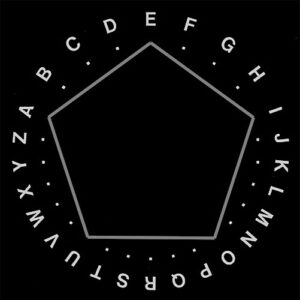
The circular alphabetic configuration is organized by positioning the consonants between a symmetry of vowels (the configuration is based on a circle because it is the only two-dimensional shape that doesn’t have inherent spatial variation on its perimeter). When lines are drawn within the alphabetic circle that connect the letter-points according to the spelling of words, visual forms are generated. Since the process is rigorous and the configuration of alphabetic points is fixed, all variations in the imagery are the direct result of the spelling of words.
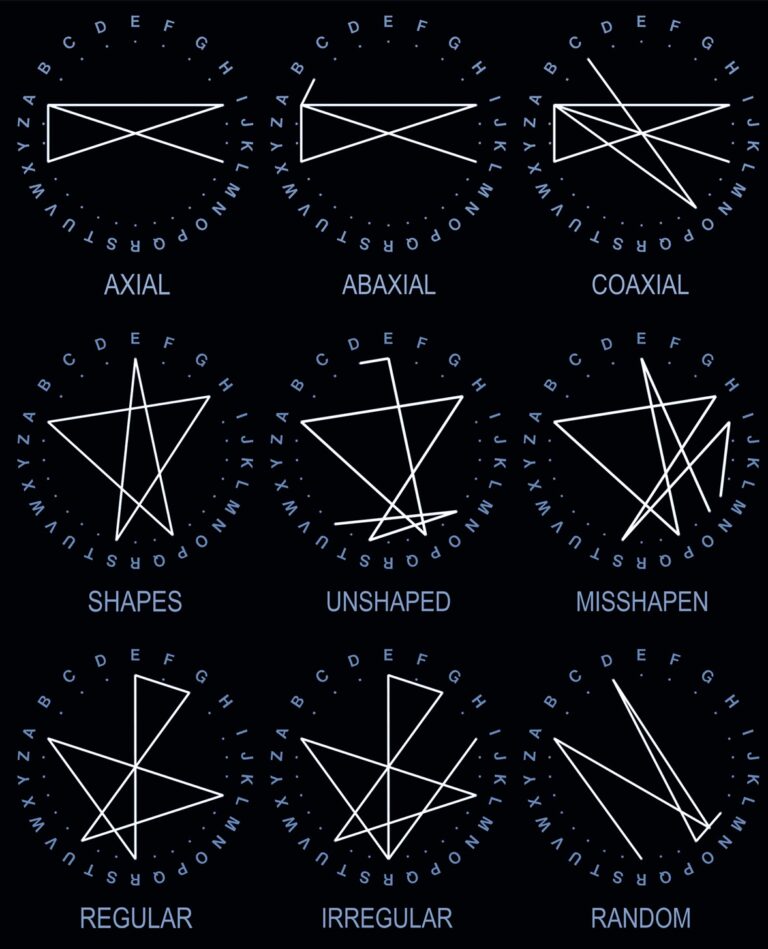
Winkler’s project has attracted interest both within and outside the art community, partly because it aligns with recent research in the science of how we read words. It’s been discovered that recognition of the code of alphabetic sequencing (the patterning underlying orthography or spelling) constitutes the sign for a written word, not recognition of a word’s graphic shape or image, as had been thought (Bouma Theory was incorrect; the new theory is Parallel Letter Recognition). Similarly, the sign for a spoken word resides in recognition of the patterning of the underlying vocalic gestures, not in recognition of the phonemic components themselves. The recent discoveries are problematic for cultural theorists and contemporary philosophers (Ferdinand de Saussure never examined the patterning of vocalic gestures, so his widely accepted assumption that the signs of language are arbitrary is groundless. Most theories are based on Saussure’s assumption).
The orthography of English words was not devised according to a plan, so any perception of a meaningful relationship between a word and the alphabetic patterning of its sign is inexplicable. It’s not impossible that the culturally mediated sense of a meaning unintentionally influenced the evolution of its sign. Until spelling was standardized in dictionaries, it evolved as all signs in living language evolve–it was formulated by the choices of the collective awareness of all those who participated in the evolution of the language (some of Winkler’s works explore the similarity between alphabetic patterning and early artifacts of the emergence of the symbolic mind). Michael Winkler wrote: “The signs of language are the primary external manifestation of human consciousness. The choices that created them evolved organically. They’re similar to choices in automatism and abstract expressionism, except that they result from collective activity extending back to the origin of the word, rather than from the non-rational or subconscious activity of an individual person. Although the choices may have been mediated by cultural influences affecting the perception of the phenomena being signified, the choices themselves were always formulated, altered, and reaffirmed based on innate features of language creation (the signs of written language are now standardized in dictionaries, but all signs for words initially took shape in a context of intuitively organized relations, and when those relations were modified, it was through the natural evolution of language).”
However, he also says, “The imagery is presented in the context of art, not science. In most instances, the imagery’s association to the words can’t be rationally evaluated, because there are no established visual references for the meanings of most words. Assessments of meaning must be primarily based on intuitive responses and other non-rational aspects of visual experience. If the patterning of the alphabetic sequence is meaningful in relation to the word that it signifies, it isn’t resulting from something that was intended to be visualized. If the meaning is not accidental, it may result from something organically responsive to meaningful experience that is deep within the nature of our consciousness. It could be evidence that human awareness arises from a phenomena of relational patterning that is no less organic than the code that establishes the genetic design of our physical bodies. If this is true, the implications are profound. But the role of art is to evoke questions, not answer them. The technical and philosophical information is only provided to dispel common misconceptions and ensure the imagery is approached with an open mind. There are other philosophical explanations, such as the Jungian conception of universal synchronicity, and there are some people who don’t see any word-related meaning in the imagery. As in all art, no two perceptions of the imagery will be identical.”
To learn more about Michael Winkler’s research into the signs of language and its implications; see this excerpted chapter from The Image of Language.
LIGNS Print Series (click on the images to enlarge them)
Thousands of words in over a dozen Romanized languages have been explored.
The untitled work above was commissioned by Daimler Mercedes-Benz in 2015 (click on the image to enlarge it). It’s mixed-media on stretched canvas, height 183 cm, width 142cm (72 x 56 inches). It was created in a studio set up on-site as part of a special project at the Daimler Mercedes-Benz plant in Kassel, Germany. In this work, a common origin of basic forms inherent in the mechanism of human perception is treated as underlying both the patterning of the signs of language and the structure of mechanical systems. The work includes the 2000 year-old Antikythera Mechanism which uses 37 gears to accurately predict astronomical events. It illustrates how cosmological phenomena are also mirrored in the natural formation of language, sensory perception, and the structure of mechanical systems. The work is based on the spelled-forms of 12 German words–it includes one of Michael Winkler’s favorite words in any language, Variantenapparat (all possible variations).
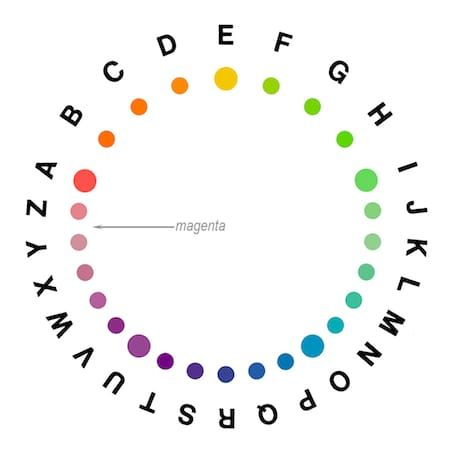
In the mid 80’s, he started exploring the imagery in the media of painting. He continues to work in a wide variety of media, but painting gradually became a primary focus after, in 2013, he devised a method for producing word-generated paint colors. The original method has been refined, but the basic approach has always been the same. An Alphabetic Color-Wheel was created by mapping the fixed configuration of alphabetic points onto a CIECAM Color-Wheel of pigments. The tint-strengths of the pigments at the locations of the five vowels are equalized using various mediums. The colors of the consonants between the vowels are created by proportionally mixing the vowel pigments. A proportionally diminishing series is then used to mix the alphabetic pigments according to a word’s letter sequence, so that words containing the same letters in a different order will not produce the same color. In the 2023 paintings, the background is the pure color created by the word, but the three shades of the lines of the form consist of three different values of a mix of magenta and a fixed percentage of the word-generated color.
The color magenta doesn’t align with any of the letter-points of the alphabetic configuration (it is located at a 90 degree counterclockwise point between the letter-points ‘Y’ and ‘Z’). Its location on a CIECAM Color-Wheel defines an horizon-like point of equatorial orientation. Magenta is a unique color. It can’t be found on the Natural Spectrum–there is no wavelength that corresponds to its color. It’s a mixture of red and blue light that appears to be magenta as a result of how our brains and sensory system process the perception of light. The word-generated color is being harmonically experienced in relation to a perception of light that is constructed by the organic mechanism of visual experience. Winkler says he is “exploring the possibility of revealing a luminous resonance between the intuitively designed patterning of the linguistic sign and an organic feature of human awareness.”
______
The method of research used to explore the phenomena of the signs for words has been applied to research of other phenomena, such as the patterning of the distribution of prime numbers, and the nature of the geometric archetypes that appear in artifacts of the emergence of the symbolic mind.
